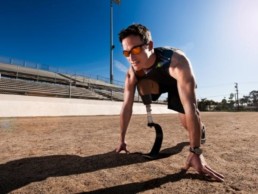Servicemen and Service Dogs: A Life Saving Connection
Our servicemen and women have to restart their lives upon returning home from battle. These new challenges can present circumstances far different from those of war. Facing these challenges head on can be daunting for many. Easing back into society can tough, especially for those who suffer from Post-Traumatic Stress (PTS) and Traumatic Brain Injury (TBI). According to the Veterans Administration (VA), between 11-20% of veterans during Operations Iraqi Freedom (OIF) and Enduring Freedom (OEF) have been diagnosed with PTS in a given year.
There are a variety of ways to ensure that transition is as smooth as possible. One of those methods is pairing a Veteran with a service dog. Suffering from PTS can leave an individual feeling isolated from family and friends. Depression and other emotional disorders can surface as well. The method of service dogs is to provide the veteran with a companion trained to help them with basic needs. However, the animal is indirectly re-teaching the veteran how to care for someone, using emotions as communication, and even how to love.
“We think pet dogs, therapy animals and service animals all have a role to play in peoples’ health and veterans’ health. This is all good news. A cold nose is a powerful motivation to get up in the morning,” said Stave Feldman, executive director of the Human Animal Bond Research Institute Foundation. Mr. Feldman discussed studies between the animals and veterans to The Military Times in a recent article.
“He brought me back from the brink,” said Veteran Colonel Roger Lintz, (US Army – Retired) of his Service Dog – Niles. Living with PTS does take time to accept that life may not be the same. This veteran, who honorably served his country, was able to find true companionship with his new four legged friend. Niles was able to help him with remedial tasks around the house and would wake him from nightmares. These nightmares and other issues with PTS nearly became too much to handle. Col. Lintz believes that his companion saved his life when suicidal thoughts started to cloud his mind. Watch the full interview:
The American Psychology Association and The Society Military Psychology have found that this alternative method could help nearly 40% of veterans. Especially those who do not show signs of improvement after participating in treatments such as prolonged exposure (PE) and cognitive processing therapy (CPT), which are considered the “gold standard” for treating PTS.
Maj. Todd Olsen had participated in multiple tours of duty since enlisting in the Army in 1989. However, coming back after his last mission sent his life into a tailspin. He was suffering from multiple symptoms of PTS, rebuilding a relationship with his two boys, and filing for divorce from his wife.
Some servicemen and women will attend the actual trainings with their service dog. They get to watch them go through obstacle courses, learn commands, and how to save lives. This, in a way, gives the veteran a sense of purpose again. Their life and bond matter as much to the service dog as the service dog means to them.
Maj. Todd Olsen of Pennsylvania told The Daily Progress that, “It’s not so much training the dog, it’s training the veteran and then pairing them up together. So we weren’t teaching them basic obedience, we were learning the commands and the dogs were learning how we give the commands.”
There have been few in-depth studies about the dynamic between a service dog and PTS. However, The Veterans Administration believes that veterans can experience some needed benefits by owning an animal or being paired with a service dog. The VA also counsels that veterans should speak with their doctor and family before applying for a service dog.
What are the emotional benefits of having a dog?
Dogs can make great pets. Having a dog as a pet can benefit anyone who likes dogs, including people with PTS. For example, dogs:
-
Help bring out feelings of love
-
Do things that are different from natural dog behavior
-
Do things that the handler (dog owner) cannot do because of a disability
-
Learn to work with the new handler in ways that help manage the owner’s disability
-
Are good companions
-
Take orders well when trained. This can be very comfortable for a Servicemember or Veteran who was used to giving orders in the military
-
Are fun and can help reduce stress
-
Are a good reason to get out of the house, spend time outdoors, and meet new people
(Source: The Veterans Administration)
Maj. Todd Olsen continues his transition into “civilian life” by working with his service dog and attending yoga classes. He says, “With the yoga for veterans and the dog, and continuing treatment at the VA, it’s putting me back together.”
The Purple Heart Foundation has provided funds to service dog programs totaling $75,000 over the years. The Purple Heart Foundation remains committed to assisting veterans in all aspects of their lives, including service dog programs, other rehabilitative programs, and disability benefits. You can show your support for these brave men and women who have sacrificed so much for our country by making a one-time or monthly pledge to ensure veterans continue to get the support and benefits they deserve by clicking here.
Paralympics Rio 2016
This year’s Olympic games in Rio de Janiero, Brazil was full of exceeded expectations, excitement, and more. In addition to Simone Biles, Michael Phelps, and other Olympians, there were 19 servicemen and women who qualified for a position on the Team USA roster–15 active-duty personnel, 2 veterans, 1 Navy civilian, and 1 incoming midshipman to the Naval Academy, including Spc. Dan Lowe, Regine Tugade, and 2nd. Lt. Sam Hendricks.
Out of all 121 medals, Army Specialist Paul Chelimo received one of the 37 silver medals awarded. Chelimo, who was born in Kenya, won the silver in the men’s 5,000 meter run. After the race, he was informed by a television reporter that he was disqualified from the race for infringement in another athlete’s lane, but the ruling was later overturned. Chelimo ran his best time of 13 minutes, 3.94 seconds, right behind Great Britain’s Mo Farah.
Chelimo was a part of the U.S. Army World Class Athlete Program, which he credits for being the reason he was able to compete in Rio, “I’m only here because of these Army Soldiers,” Fanning said. “That’s the reason I’m part of this delegation. But it was fun for the entire delegation to have an extra reason to cheer, not just for the United States but for the Army, so they were screaming loudly for him: ‘Who’s your Soldier? Who’s your Soldier?’”
Chelimo’s next tour will not be overseas with fellow soldiers, but throughout the United States as a trainer with the World Class Athlete Program, inspiring the youth in this country to follow their dreams.
With the Olympics at a close, it’s time to turn our attention to the 15th Paralympic Games, which will also be held in Rio. Of the Paralympians competing, there are 20 soldiers, six Marines, three sailors, and one airman across the 23 sports being showcased.
In addition to Brad Synder, a sailor who lost his eyesight in Afghanistan and holds the world record for the blind 100-meter freestyle, there is Anthony McDaniel competing in Para Rugby and Elizabeth Marks, competing in Para Swimming, among other athletes and veterans. McDaniel lost his legs and left hand in 2010 from an improvised explosive device while serving as a Marine in Afghanistan and Marks suffered severe hip injuries while an Army combat medic in Iraq in 2010, which left her with no sensation in her left leg.
McDaniel said back in 2014 that adaptive sports helped give him a sense of tranquility after spending more than a year in rehab following the IED explosion in August 2010, “It’s just been helping me stay focused and positive,” McDaniel said. “It keeps me out and active every day.”
Marks told ESPN that the medals she earns in her competitions are not the end game–to her, the process of competing is more gratifying and thinks back to helping others during her time as a combat medic, “When I step onto the blocks, I never think, ‘I want to win,’” she says. “I think, ‘I want to pour all of myself into this race because there are people who can’t physically, mentally or emotionally, do that.’ So it’s my way of performing for them.”
The Paralympics are now days away from the start of the 15th Paralympics. It runs from September 7-18. We salute these servicemen and women and are excited to see how they compete and represent the United States and their respective military branches.
The Purple Heart Foundation is committed to assisting not just the Veterans of the Paralympics, but all veterans who have served our country. Show your support for these brave men and women by making a one-time or monthly pledge to ensure Veterans continue to get the support and benefits they deserve by clicking here.


